

Almost anyone who ever listened to radio has at some time or other, heard the famous three note chime that has been the long time trademark of NBC. These chimes were used on the hour and half-hour to announce station breaks on the network.
![[1st NBC Logo]](images/nbcmiclogo.jpg)
![[Promo chimes]](images/nbcchimes/studiochimes1.jpg)
"This is NBC, the National Broadcasting Company, Bong
Bong Bong."; 

Almost anyone who ever listened to radio has at some time or other, heard the famous three note chime
that has been the long time trademark of NBC. These chimes were used on the hour and half-hour to
announce station breaks on the network.
I became interested in the history of the chimes after discovering a book at the library titled The Fourth Chime by NBC, printed in 1944. I had never heard of a "fourth" chime and my curiosity was aroused. I checked out the book to find out more about this extra chime. However the book told very little about the fourth chime, but dealt mainly with the role NBC played in the reporting of special world-wide news events, primarily during World War II.
I began to seek more information about this fourth chime. Was it a different note from the other three or maybe a repeat of one of the others? Where could I get a recording of this fourth chime?
A letter to the editor of Antique Radio Classified brought some results. My request for more information was published in the December 1994 issue of ARC Radio Miscellanea column, and shortly I received a letter with a copy of an article from Radio Age by Rod Phillips about the history of the chimes3. I also made inquires on the Old Time Radio Digest on the Internet. I was particularly looking for a recording of the fourth chime. The response was great to say the least, and I began to be able to put the pieces of the puzzle together. A recent trip to the Library of Congress in Washington DC also turned up more interesting information on the history of these three little notes.
NBC - New York...The National Broadcasting Company was incorporated on September 9, 1926 under the laws of Delaware.1 It was a corporation owned jointly by RCA (50%), GE (30%), and Westinghouse (20%).1 The NBC network began broadcasting on November 15 of the same year from studios WEAF in New York City. There was a combined group of nineteen scattered affiliated stations, using more than 3500 circuit miles of telephone wires.2
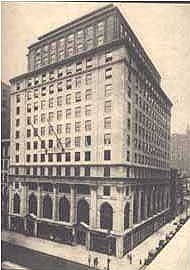
|
At the end of a program the NBC announcer would read the call letters of all the NBC stations carrying the program. As the network added more stations this became impractical and would cause some confusion among the affiliates as to the conclusion of network programming and when the station break should occur on the hour and half-hour. Some sort of coordinating signal was needed to signal the affiliates for these breaks and allow each affiliate to identify. Three men at NBC were given the task of finding a solution to the problem and coming up with such a coordinating signal. These men were; Oscar Hanson, from NBC engineering, Earnest LaPrada, an NBC orchestra leader, and Phillips Carlin, an NBC announcer.
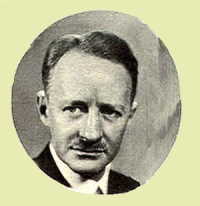
|
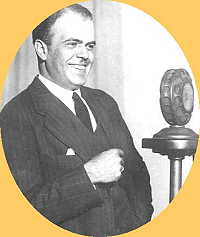
Radio Broadcast-September, 1926 |
WSB - Atlanta...I received information from a person who worked for WSB-TV in Atlanta , Georgia for 24 years, that the chimes had their origin at Atlanta radio station WSB. Supporting this, Paul Terry phoned in the following to the St. Petersburg Times that appeared in the February 9, 1995 Action,column.
"I read in your Jan. 17 Action column that NBC officials said the chimes used for network identification are the musical notes G, E, and C and originally stood for General Electric Corporation which was part owner of NBC.""I think if you research this a little further you will find that the chimes really originated in Atlanta, GA., at radio station WSB."
"In the late 1920's, WSB station manager Lambdin Kay began using a miniature xylophone to hit those same three notes to signal station breaks. Later, when WSB joined the NBC network, WSB cut in one day during a Georgia Tech football game with the chimes. NBC liked it so well that it got permission to use the chimes for its own identification." 4
Terry, 87, started working for American Telephone at age 12 and retired 52 years later. When not working he would hang around station WSB, and that is how he came to know about the chimes. Mr.Terry passed away two days after phoning in his story to the St. Petersburg Times. Elmo Ellis who was hired by WSB in 1940 and retired as general manager of the station some years ago, confirmed Terry's story.
WSB claims to be the first radio station to use a musical identification at the end of its programs.5 The xylophone that Lambdin Kay used was given to him by a young lady, Nell Pendly, the night she and her twin sister Kate, appeared on the station.
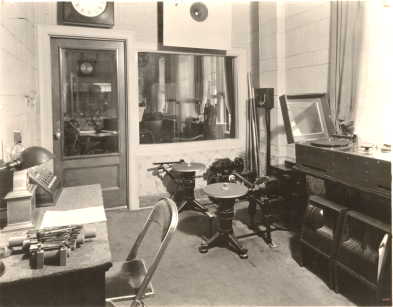
|
The four bar xylophone given to WSB Station Manager Lambdin Kay by Nell Pendly can be seen on
the table in the lower left of the photo. (Photo from the book "Welcome South Brother" - courtesy WSB
Radio and Cox Enterprises, Inc., Atlanta, GA.)
Click image for enlarged view of the WSB chimes
WGY - Schenectady...The following information was received via e-mail from a former Program Manager at WGY which was the flagship station of the General Electric Company at Schenectady, New York. WGY went on the air February 22, 1922 with 1,500 watts of power.2 During this Program Manager's tenure, the station celebrated it's 50th anniversary. In doing research in preparation for a documentary on the station's history, the researchers found what they believe pointed to the chimes origination at WGY. The research indicated that about a year after the station went on the air, the notes G-E-C were used as an identification and stood for the General Electric Company...the notes were sounded on a piano.
KFI - Los Angeles.... This station, which went on the air in April of 1922, also lays claim to be where the chimes originated. Broadcaster-historian Frank Bresee, related the following to me. In 1972 he wrote and produced the 50th Anniversary program for KFI. One of the NBC stars appearing on the program was long-time announcer Ken Carpenter. He began his career at KFI and related to Mr. Bresee that upon joining KFI in 1930 he was told that the chimes originated at the station when it opened in 1922. They wanted a way to identify the closing of programs so they used the familiar notes and this was later picked up by NBC.
So we have four stories to choose from, all claiming to be the originators of these famous three little notes of broadcasting history. To whom do we give the credit? Without any concrete documentation or first hand knowledge of someone who was actually there at NBC when the decision was made to use those notes, I don't think we can really say just who the credit goes to. All of the stories are plausible and no doubt true to the extent that WSB, WGY, and KFI were using these tones or a combination thereof for an audible identification before the birth of NBC. As far as the decision to use them at NBC and from what source they came, as I stated earlier in this article, only those who were directly involved really know the true story. Sadly they are no longer with us to confirm what we wish to know. Perhaps buried somewhere in some long forgotten NBC archive lies the answer, but from where ever they came, those three little notes became one of the most recognized sound trademarks in broadcasting history.
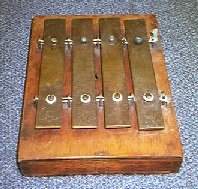 |
I wondered if any original Degan hand chimes used by any of the affiliate network stations still existed. Degan custom manufactured "Studio" chimes for NBC, and as Rod Phillips mentions in his article, these chimes only had three bars, mounted in G-E-C striking order. As he describes them; the bars were mounted on a wood resonator box and padded on the corners with leather bumpers. A cast aluminum handle was attached on one end of the box to enable the announcer to hold the chimes close to the microphone and strike the notes in order.
I did quite a bit of research and searching to find a set of these three bar chimes but finally came to the conclusion that probably not many of these custom Deagan "Studio" NBC chimes were produced and thus fairly rare, and perhaps none no longer existed.
A search on the Internet did produced an article about television station WCSH in Portland Maine being sold by the family who were the original owners of the station from the time it was one of the original NBC radio affiliates. The grandson of the stations founder and current owner stated that the station still had the original hand chimes used at the radio station to sound the tones on the NBC network, and these chimes were currently on display in the lobby of the station. Perhaps these were the three-note chimes I was looking for, however the chimes used at WCSH turned out to be the Deagan 400 Series" dinner chime. The four note "400 and 200 Series" Deagan dinner chimes are often mistaken for the "real" NBC Chimes. The 200 Series was used by WSB as mentioned earlier. At right is a picture of the original WCSH Deagan chimes. As shown in the photo, the four bars are mounted on a wood sound box, the bars being held above the box by cords pulled taut through metal eyelets. A small felt mallet was used to strike the bars. These off-the-shelf dinner chimes could be found in use at a number of places. Railroad porters used them on passenger trains to announce when meals were being served in the dining car. They were used for similar purposes at hotels, resorts, on cruise ships and even in private homes. The Deagan company was eventually sold to the Yahama Music Company.
I received an email from a fellow NBC chimes enthusiasts about a set of chimes he had acquired from an on-line auction site. These were the three bar "Studio Chimes" as described above, so now there was proof that such chimes do indeed exist. (Check out the link to Michael Shoshani's "NBC Chimes Museum" web site below)
As luck would have it, some time later, another set of these chimes came up for auction, and I managed to snag this set for myself, (pictured below) so now there are two known sets of existing NBC Studio Chimes. As you can see, they fit the description given by Rod Phillips. The chimes carry an NBC Engineering Department inventory tag with the serial number 1812.
Click picture to view larger image
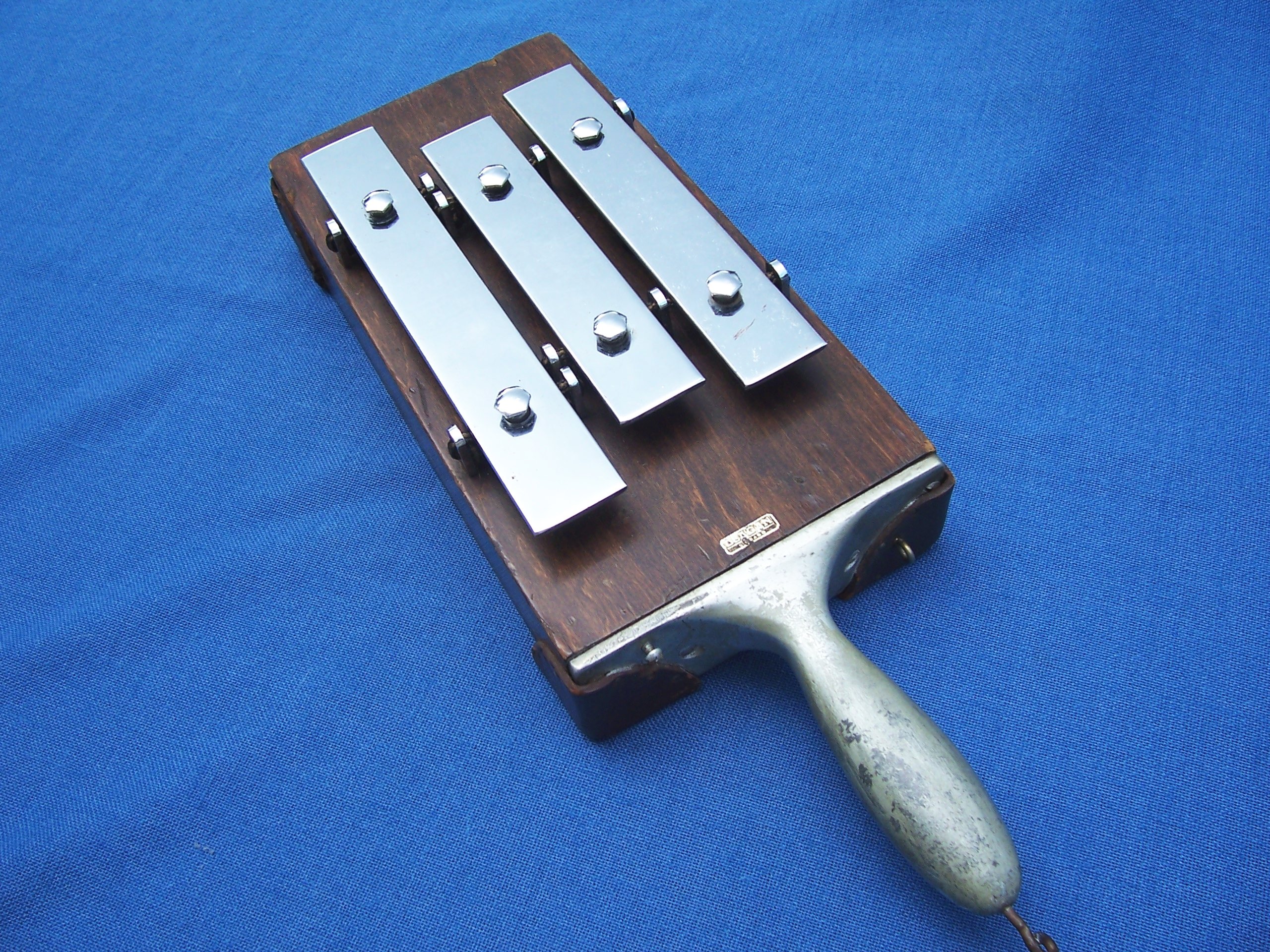
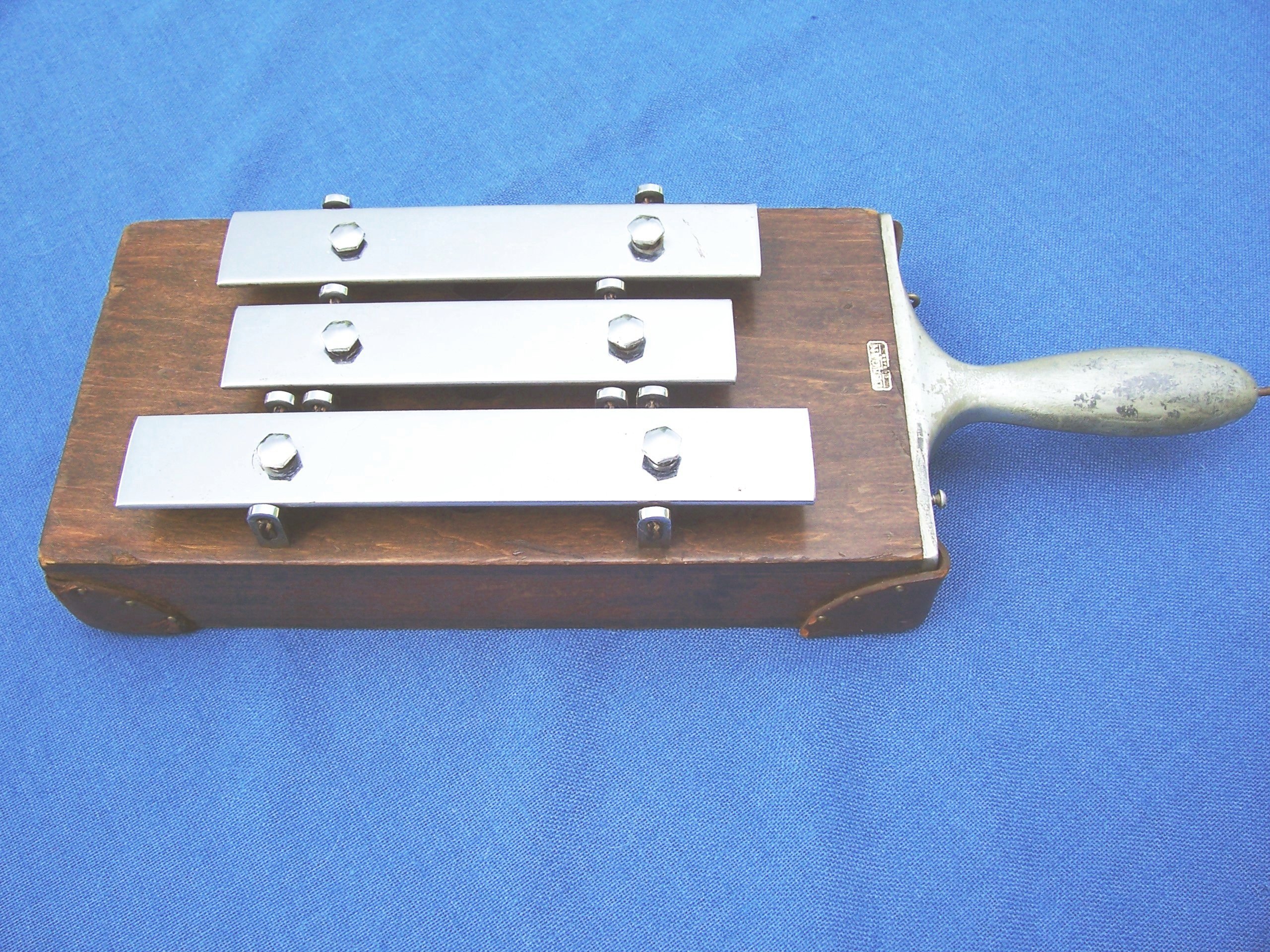
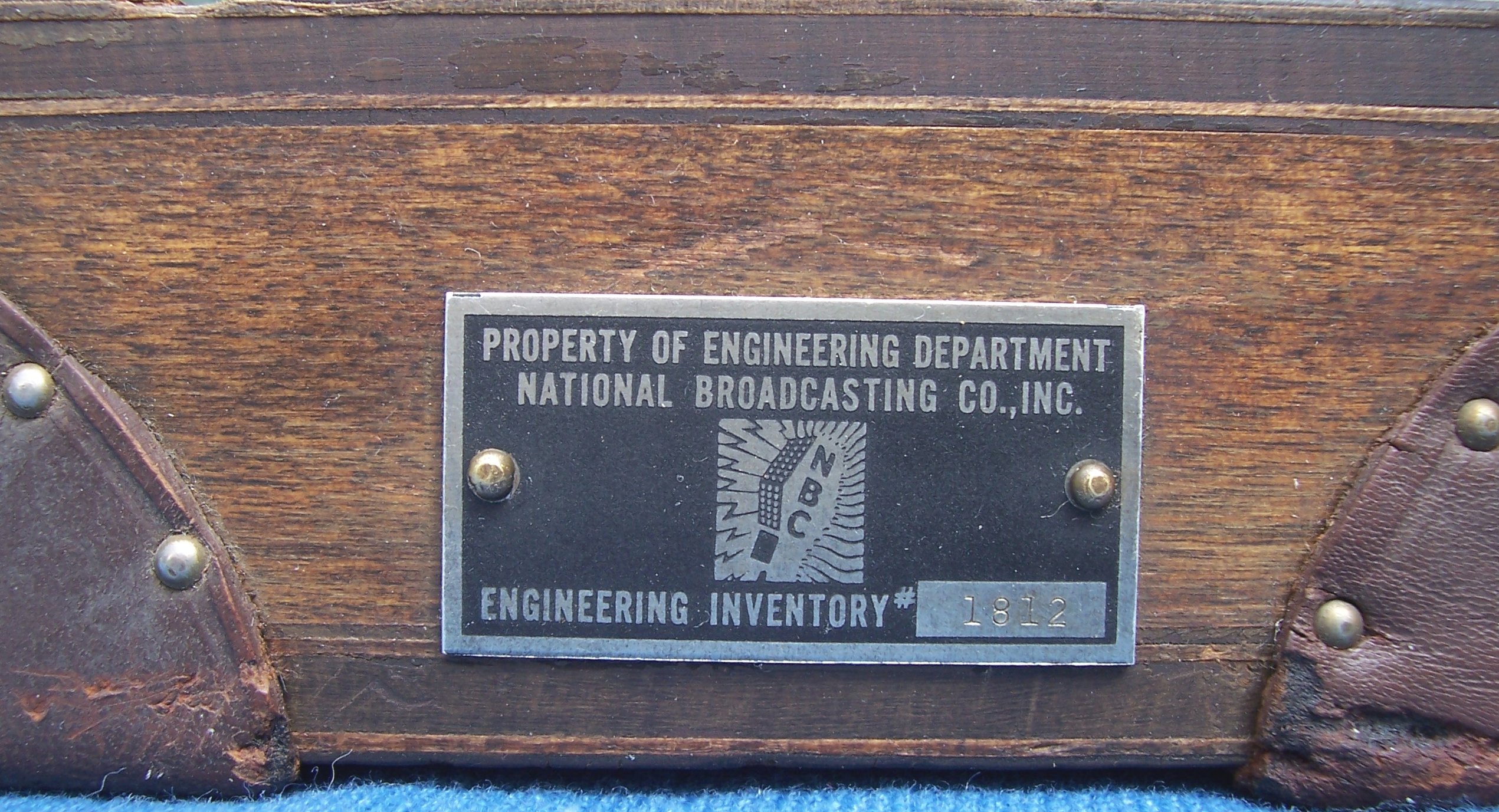
|
In 1932, two NBC engineers, Robert M. Morris, and O. B. Hanson visited a Captain Richard H. Ranger at his home in Newark, New Jersey. The purpose of this visit was to see an electronic organ Captain Ranger had invented. Morris describes the organ as "quite complex, and had many features of the pipe organ but the equipment consisting of countless tubes, relays, oscillators, amplifiers, filters, modulators, etc., occupied all of a two car garage." 6
After their inspection of the electronic organ was complete, Captain Ranger accompanied Morris and Hanson to the Robert Treat Hotel for some refreshments. It was here that the subject of a possible electronic version of the NBC Chimes arose. It was suggested that Captain Ranger design such a unit and present it as a proposal to NBC.
Approximately a month and a half later Captain Ranger had a working model. The machine was an electro-mechanical device constructed much like a music box. A set of finely tuned metal reeds were plucked by the fingers on a revolving drum. The metal reeds formed a capacitor of an oscillator circuit, this varying signal was amplified and sent out over the network.
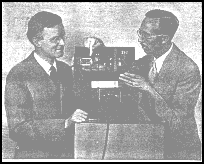
|
Initial tests of the Rangertone Chimes indicated a tone quite different from the soft-toned hand-struck Deagan chimes. This problem was referred to the music department and Earnest La Prada was assigned to work with Roland Lynn of the NBC Laboratory to see if a better tone quality could be produced, and after many days of effort, the desired tone was achieved. After necessary circuit changes were made in the studio control system the new electronic chimes were put on the air in New York on September 17, 1932,13 and now the famous chimes could be sounded with the simple push of a button. Additional units were ordered for other major NBC studios. An announcement of the introduction of the electric chimes appeared in the October 1, 1932 issue of Radio World. The Rangertone chimes were used up until sometime around 1939, at which time they were replaced by all electronic chimes developed by the NBC Laboratory.7
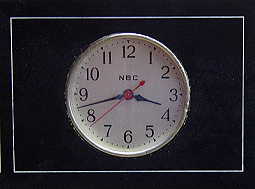 |
Not everyone was thrilled with the chimes. The number of complaints about the chimes decreased after the automatic chimes were installed and the chimes were no longer hand-struck, however there were some who wanted to change the sound of the chimes or eliminate them altogether. A memo from John F. Royal to O. B. Hanson suggested that the cue used originally "National Broadcasting Company" should be sufficient and the chimes were not really necessary. His opinion was that the chimes had become "monotonous" and "we could devise something much pleasanter (sic) to listen to than the three-note chime - something with some real music in it and that could be changed from time to time to relieve the monotony and still retain the identity".17
W.F. Fairbanks in an Interdepartment Correspondence to Mr. Keith Kiggins suggested that the chimes on the Blue Network be different from the Red Network chimes.19 "Specifically, I would like to see some serious consideration given to a change in Blue Network chimes that would unquestionably identify the programs being carried over this network." He suggested adding 4, 5, or 6 carefully selected notes to the present three-note chime so the well known NBC musical trade mark would be retained but would give the Blue a unique label.
There were several letters from listeners who suggested changes to the chimes. In a letter to General Sarnoff, the head of RCA, a Mr. Reily wanted to "change the notes so they sound like NBC." In a reply to Mr. Reily, Niles Trammel explains that there is no "N" note and that experiments had been done using the Sonovox system to modulate the voice of an announcer with the musical notes as he spoke the letters NBC, but found it to be "unharmonious."18 Another suggested to make the chimes sound like the Morse Code for the letter "V" to aid in the war effort. Roy C. Witmer responded to that suggestion in a memo by saying, "If I thought for one moment that sounding the letter "V" on our chimes even a million times would contribute in the slightest to winning the the war, I would certainly vote for it with all my might. However, to me a thing of that kind is just plain silly and accomplishes but one thing - it confuses everybody".18
In a 1940 Interdepartment Correspondence from A. L. Ashby to Niles Trammel22, someone had suggested using the phrase "When you hear the chime, it's NBC time" immediately following the chimes. Another suggestion was to have a vocalist sing the letters N B C to the tune of the chimes.
Even automobiles were trying to get into the act. In a memo from E.P.F. James to Mr. Ken R. Dyke, James asked the Purchasing Department to investigate the possibilities of contacting the manufacturer of the horns used by the trolley buses at the New York World's Fair that play the tune "The Sidewalks of New York", to have automobile horns made that would play the NBC chimes.20
The fourth chime, is what started my interest in this subject. The book The Fourth Chime stated that it was originally contrived as a confidential alert to signal the members of the NBC news staff, engineers, and other personnel responsible for broadcasting the news to the people. The book states that it was first heard on the air with the crash of the dirigible Hindenburg, May 6, 1937 at Lakehurst, New Jersey, however an NBC Interdepartment Correspondence memo, dated April 7, 193311 documents the conception and initial purpose of the fourth chime. The memo states, "In anticipation of the Spring and Summer months, when many in key positions will not always be available at home telephones, the following Emergency Call System will go into effect on Monday morning, April 16th." The memo goes on to say that whenever a fourth tone is heard on the network chimes rung at fifteen minute intervals, it will indicate that someone on an attached list is wanted. Upon hearing this fourth chime, all personnel on the list are instructed to call in to the PBX operator to ascertain whether or not the Emergency Call is for them. The chime would continue at fifteen minute intervals over stations WEAF and WJZ until the wanted person communicated with the PBX operator. The list contained the names of the following NBC executives:
I believe that the above confirms that the original purpose of the fourth chime was not necessarily an alert to signal news breaking events, but simply a call system, much like a paging system today, for key personnel to call the office. The sounding of the fourth chime with the crash of the Hindenburg was the first use of the chime as an emergency alert signal by NBC News and Special Events to alert NBC staff and other personnel of a breaking news event.
It was fortunate that Chicago radio station WLS news reporter Herb Morrison was sent to Lakehurst, New Jersey that day in 1937, with a recording device to record sound effects of the Hindenburg landing. The arrival of the Hindenburg was not particularly a news worthy event as the landings had become quite commonplace, so little did Morrison know that he was about to make one of the most famous recordings of a news event in history. With the airing of portions of Morrison's recording the next day over both the Red and Blue networks, NBC's strict rule against using recorded material for broadcast was broken for the first time in it's history so the radio audience could hear this dramatic eye-witness account of this tragic event. Jack Hartley, a reporter and member of one of the NBC Mobile units that was dispatched to the crash sight is quoted in the book I Live On Air,10 "There were about a dozen of us in the original party that left with Mobile Unit No. 1. Shortly before we started, we broadcast an emergency signal to all of those attached to the News and Special Events Department in the New York Office. This was done by means of the fourth chime." Both WJZ and WEAF, the Blue and Red network stations in New York broadcast the signal.10 The fourth chime was sounded again during the Munich crisis in 1938, with the news of the bombing of Pearl Harbor, December 7, 1941, and during the early morning hours just preceding the bulletins announcing the D-Day invasion June 6, 1944.
The fourth chime continued to be used throughout World War II to alert the NBC news department and the radio audience of special news bulletins.
"The Fourth Chime will ring out again and again from the NBC News room in New York whenever events of utmost significance demand the intensive nationwide coverage of the news the American people have come to expect from the National Broadcasting Company." 8
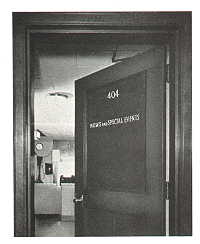 |
I received a tape of a documentary produced by a radio station in Washington D.C., of NBC news broadcasts of the 1944 D-Day invasion of Europe. In one of the early morning bulletins, just before the announcement of the beginning of the invasion, the fourth chime can be heard. Rod Phillips wrote in his article on the history of the chimes that the fourth chime was a second strike of the "C" note, and this is in agreement with a June 6, 1964 NBC memo from the Press department12. I therefore assumed that the fourth chime sequence would be G-E-C-C. I was surprised at what I heard on the tape. The sequence of the notes was B-D-G-G, in the key of G. If you transpose this sequence to the key of C, they become E-G-C-C. As stated in an earlier paragraph the note arrangement of E-G-C are the notes as originally used by radio station WSB, and the first three notes of the World War I song Over There.
Why did NBC use that sequence for the fourth chime? Was there some patriotic reason because of the war song, or did it just sound better than G-E-C-C? Why was it sounded in the key of G instead of the key of C? Perhaps they wanted a different sequence and tone that would not be confused with the so familiar G-E-C notes and would be more likely to catch the attention of the listener and NBC news staff, or perhaps it was just a mistake by the person striking the chimes.
According to the book, the fourth chime was sounded two times during the D-Day broadcast, once at 2:30 A.M. to put the network on a flash basis; the chime alert calling all newsmen and commentators to their microphones, and key operating personnel to their stations. Then at 3:18 A.M. the chime was sounded once more, followed a second later by the Morse code V (dit-dit-dit-dah) for Victory, repeated 5 times .
An NBC memo from the Press Department dated June 12, 1964 commenting on the uses of the fourth chime, there is a hand written comment that the last use of the fourth chime was in 1985 when GE announced it's merger with RCA.12
Legend has it that the notes G-E-C were chosen because those were the initials of the General Electric Company, a part owner in NBC. I have found no hard documentation to substantiate this claim, however, the WGY claim of using those notes because of their affiliation with the General Electric Company has merit. I think one could surmise that since WGY sounded the notes on a piano, which offered a choice of 88 notes to chose from, the choosing of G-E-C was not accidental. However if we look at the Deagan hand chimes used by others, the four notes are G-C-E-high G, so it isn't difficult to see that with only those four notes to work with, G-E-C could easily have been chosen without any intended reference to the General Electric Company. So except for WGY, the use of G-E-C may have been just coincidence. In defense of this, in 1938, NBC engineer Morris made a trip to various European countries to observe the progress of television in Europe. D. C. Brinkenshaw of the BBC commented how he liked to listen to the States over short wave from the General Electric station at Schenectady N.Y. Mr. Morris states;
"He thought it most ingenious of them to use an aurally coded identification for the G. E. stations by using chimes with the notes G-E-C for General Electric Company. I tried to persuade him that the chime signal came from NBC and had nothing to do with General Electric. I'm not sure he really believed it." 6
Serial Number : 72-349496
Type of Mark: SERVICE MARK
Mark Drawing Code: (6) NO DRAWINGDescription of Mark: THE MARK COMPRISES A SEQUENCE OF CHIME-LIKE MUSICAL NOTES WHICH ARE IN THE KEY OF C AND SOUNDED THE NOTES G, E, C, THE "G" BEING THE ONE JUST BELOW MIDDLE C, THE "E" THE ONE JUST ABOVE MIDDLE C, AND THE "C" BEING MIDDLE C, THEREBY TO IDENTIFY APPLICANT'S BROADCAST SERVICE.
Owner Name: NATIONAL BROADCASTING COMPANY, INC., THE
Owner Address: 30 ROCKEFELLER PLAZA NEW YORK NEW YORK
10112 CORPORATION DELAWARE 9
NBC discontinued the use of the chimes in 1971, however in November of 1976 the network began using the chimes once again following all broadcast in celebration of the 50th anniversary of the network.3 The NBC radio network was sold to Westwood One in 1987, and today the NBC radio network no longer exists. The chimes haven't been heard on the radio in a number of years and are not likely to be heard there again except perhaps as a part of an old-time radio program broadcast...and so another piece of radio history fades into the past. However, the NBC Television network occasionally uses musical variations of the chimes at the top of the hour and some affiliate stations sound the chimes during local news/weather broadcasts.
I received an e-mail from an engineer at NBC in New York City regarding the Rangertone electronic chimes machine. Sometime in 1977, one of the last of the Rangertone chimes machine was found in the trash bin and was rescued by one of the engineers. The machine was restored to working order and is now in the NBC engineering department model shop. The unit was designed to be rack mounted and is approximately 15 inches high and 15 inches deep. Another of the chimes machines is in the possession of a private collector.
It seems that today, few companies and corporations know or care little about their history and how they arrived at where they are today. I am glad this engineer at NBC had the foresight to rescue the chimes machine. The chimes were such a familiar part of radio and were, and possibly still are, one of the most recognized sound trademarks in the world, it is good to know that this important part of NBC network history has been reclaimed.
In 1938 one could order their very own set of NBC hand chimes. These were sold as a promotional item by RCA /NBC. This was a three bar chime with the note bars G-E-C mounted in that order above sound tubes with N-B-C stamped on the bars and were painted brown. A 1938 issue of the RCA magazine LISTEN contained an advertisement for the chimes. The chimes were manufactured by the NuTone Chimes Company of Cincinnati.21 The tone of these chimes is somewhat "tinny" compared to the Deagan hand chimes or the electronic chimes.
NBC presented sets of these promotional chimes to various railroads to be used as a dinner chime to signal when the dining car was open for service.21 A copy of the RCA advertisement and photo of a B & O porter holding a set of these chimes with description can be viewed by clicking here.
There have been many songs written about the chimes and even concerts performed around the famous three
notes. In 1935 Paul Whitman's band performed Announcers Blues that uses the chimes in a jazz
arrangement. The tune was written by Frank Trumbauer, the bands saxophonist and Harold Stokes. Composer
Kurt Maier wrote a composition titled "The NBC Polka", around the three notes. The selection was first
played on NBC-TV in 1949. For the 25th anniversary of NBC in 1951, a tribute to the chimes was written
by Meredith Willson, The Three Chimes of Silver12. Listen to a little
song, I Love You, about the chimes written sometime in the 1930's (approx. 2 min.).


References:
Acknowledgments
My thanks to the following individuals and companies who contributed information on the chimes:
NBC is a registered trademark of the National Broadcasting Company.
RCA is a registered trademark of the Radio Corporation of America.
GE is a registered trademark of the General Electric Company.
For an excellent look at early broadcasting history visit Elizabeth McLeod's Broadcasting History Resources
For an indepth look at the various Deagan Chimes used by early broadcasters, see Michael Shoshani's NBC Chimes Museum
The original version of this article appeared in The Reproducer, the quarterly journal of the Vintage Radio &Phonograph Society, Inc., Irving, Texas, and in Radio World for December 25, 1996.
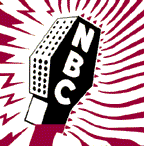 All rights reserved under the International and Pan-American Copyright Convention. The material in this article, may not be copied or
reproduced in any form, in whole or in part, without the express permission of the author.
All rights reserved under the International and Pan-American Copyright Convention. The material in this article, may not be copied or
reproduced in any form, in whole or in part, without the express permission of the author.
RCA Announces The Formation Of NBC
I welcome your comments, if you have a moment please sign the GuestBook
Last update: March, 2008
Counter Courtesy
of Webcounter
